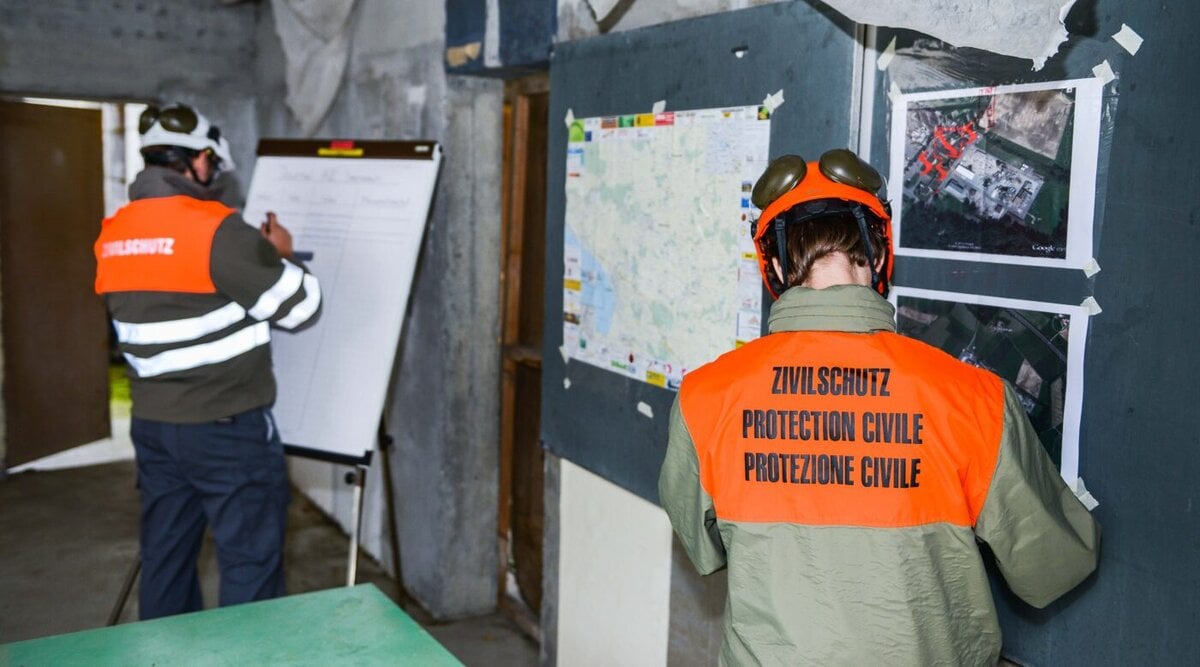Rethinking civil defense
The security situation has changed fundamentally - the coronavirus pandemic, Ukraine war and climate crisis are challenging civil protection. Michaela Schärer, Director of the Federal Office for Civil Protection, explains how civil protection is being realigned.

Ms. Schärer, what are the key innovations in the recently adopted civil protection skills profile?
Michaela Schärer: The review has shown that the existing capability profile largely meets current needs. However, a capability profile is now being defined at federal level that specifies the general capabilities of civil defense. The specific design - including organization and resources - remains a matter for the cantons.
Another important innovation is the distinction between core and extended capabilities. The former must be ensured by all cantons, while the latter form the extended framework and can be covered by competence networks.
It should be noted that capabilities in connection with armed conflicts and in the area of medical services are currently still being reviewed and specified in separate projects.
Why was it necessary to revise the previous performance profile?
The experience gained from the coronavirus pandemic and the significant changes in the security situation, particularly the war in Ukraine, have made it necessary to review and adapt the service profile.
How will the new capability profile affect civil defense training, equipment and operations in concrete terms?
Cantons that no longer adequately cover certain capabilities must (re)build them up and identify them in the target inventory. Training and equipment must also be ensured and guaranteed, e.g. for locating and rescuing.
"A population can become an important factor in the event of war."
How can uniform implementation be ensured in the various cantons?
During the spring session, Parliament passed the revised Federal Act on Civil Protection and Civil Defense. It also stipulates that the cantons must determine the required number of conscripts for civil defence based on their cantonal service profile and organizational structure and submit this to the FOCP. This procedure also allows the status of the implementation of the capability profile to be discussed in a partnership-based process.
What lessons has the FOCP learned from the war in Ukraine with regard to the resilience of the Swiss population?
In addition to lessons learned in the areas of protective structures, alerting and informing the population, civil defense operations, etc., the war in Ukraine also provides insights into how a society can successfully adapt to massive changes. The volunteer movement is particularly noteworthy. After the Russian invasion in 2022, it became clear that the Ukrainian civilian authorities and civil defense quickly reached their limits. Where there were gaps, the population organized itself independently to a high degree. For example, they help victims of the war and support refugees in their own country. They also support the civilian authorities in the distribution of relief supplies or the civil defense in rescuing rubble after rocket attacks. This shows that a population can show strong solidarity in the event of war and thus become an important factor in overcoming an armed conflict. The FOCP is convinced that Switzerland in particular, with its strong association and militia culture, has great potential in this respect. The question arises as to how optimal framework conditions can be created so that this resilience potential can be utilized if the worst comes to the worst.
How important is the modernization of protective structures?
Switzerland has a nationwide protective structure system with shelters for the population as well as protective facilities for the command and control bodies and civil defense. They form the central infrastructure for protecting the population. Maintaining the value of the shelters is therefore of central importance.
Is civil protection now increasingly focusing on scenarios of armed conflict?
Yes, the armed conflict has come back into focus with the start of the war in Ukraine. The FOCP is laying the foundations for this with the "Civil protection in armed conflict" project. It is important to note that armed conflict today is no longer the same as it used to be. Hybrid conflict management in particular, such as cyber attacks, sabotage or espionage, begins long before an actual armed attack. Nevertheless, the ability to cope with disasters and emergencies must not be weakened, as the increasing number of climate-related events shows.
How do you assess the potential of spontaneous helpers in a crisis?
There is great potential for the deployment of spontaneous helpers in the event of an incident. The FOCP has recognized this potential and will develop a basis for how it can be used.
What are the challenges of integrating them into existing structures?
Challenges include registration and reception, the coordination of operations and the allocation of tasks, control and management during operations, safety and liability issues, logistics, for example catering and accommodation, training (ad hoc) and - a key point - communication and information. It is important that spontaneous helpers can be deployed with their skills in the right place and at the right time - without endangering themselves or the emergency services.

Are there already proven models or pilot projects in Switzerland for coordinating spontaneous helpers?
In contrast to other European countries such as Germany, Belgium or Spain, Switzerland still has relatively little experience in dealing with spontaneous helpers. This is why this topic is also one of the areas of action in the "Capability analysis for civil protection", which was adopted by the Federal Council in June 2024 (1). A FOCP working group is working on this field of action together with the cantons and the SRC. Spontaneous helpers are an important topic for the SRC, which also has relevant experience.
There are cantons that have already had practical experience with spontaneous helpers, such as the canton of Ticino last year when dealing with the storms in the Maggia Valley.
"With the start of the war in Ukraine, the armed conflict has come back into focus."
What are the greatest opportunities, but also risks, in the digitalization of civil protection?
The Digitalization of Civil Defence (DIZIS) project is primarily intended to reduce the administrative workload and facilitate communication and interaction between conscripts and civil defence units. The project is being implemented via a joint platform for the armed forces and civil defense. This allows synergies to be optimally exploited.
How far has the DIZIS project progressed and what are the next concrete steps?
DIZIS will be implemented in two phases: Phase 1 (2025 - 2026) is primarily concerned with the digitalization of administrative processes with a focus on replacing the physical service booklet with the electronic service manager (DIM). In phase 2 from 2026, interactive processes are to be implemented between the cantonal civil defense offices and civil defense personnel. This includes requests for duty postponement and leave as well as the digital call-up.
How can the population be better informed, sensitized and involved in the future?
The authorities responsible for incident management can use the Alertswiss channels to inform the public. Not only does the relevant information on events in Switzerland flow together there, but the website and app also provide recommendations for individual preparedness. This makes it possible to create a personalized emergency plan that helps you to react quickly and correctly. The FOCP's strategic focus on informing, warning and alerting the population includes the continuous further development of the Alertswiss app and website. One focus of this further development is, among other things, the availability of important information on smartphones without a network connection (e.g. displaying emergency meeting points).
(1) news.admin.ch/en/nsb?id=101580









